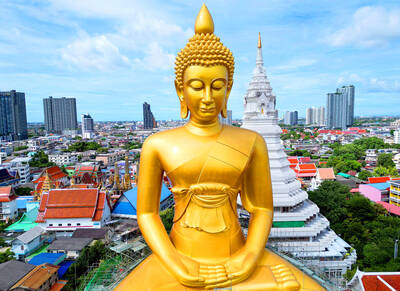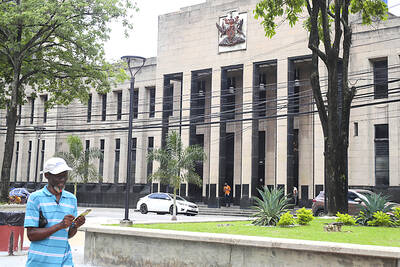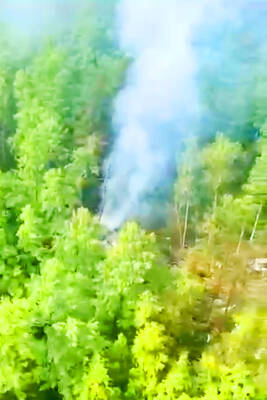Being chief curator of a disaster not yet parsed by history is a curious, close to unprecedented assignment. Possibly that best explains why Jan Seidler Ramirez, curator of the nascent memorial museum at ground zero, stashed a fiberglass Statue of Liberty, the unbuilt museum's first major acquisition, in her office kitchen under lock and key.
She holds the only key and is, she said, "very mean" about sharing it with World Trade Center Memorial Foundation colleagues anxious to commune with the coffeemaker. Kitchenette as temporary crypt, kitschy statue as museum collectible -- go figure.
Extraordinary

PHOTO: EPA
This is no ordinary collection of artifacts, and beauty is not a prerequisite. Ramirez, a museum veteran -- he was previously a curator at the New York Historical Society, the Museum of the City of New York, the Hudson River Museum and the Museum of Fine Arts in Boston -- is 55 and blessed by a freckly effervescence and the ability to pull off the same hairdo she wore at 16.
Ramirez is comfortable in the world of "Dumpster Provenance." She is not slumming it, she is deadly serious.
Instead of Rodin sculptures, the stark and homely 60 tonne Last Column from the south tower, with its eerie totemic graffiti, will anchor the exhibition. Instead of Picasso, she collates mutilated cell phones and bloodied watches; the pockmarked lump of molten metal that resembles a meteorite is, in fact, eight congealed floors from the wreckage.
Ramirez approved the meteorite for the museum after being assured by forensic specialists that no DNA could have survived.
"The etiquette quagmire we face in everything we do here has been challenging, to say the least," she said. "This is an on-site institution where, for 40 percent of the families of Sept. 11 victims, this is the last known corporal place where their loved ones existed. So a certain membrane of condolence surrounds it.
"It's not the World Trade Center History Museum, it's the World Trade Center Memorial Museum. But memory without history is potentially dangerous. Condolence is a mission. Understanding is a mission," she said.
She was hired, in April, to stock the museum with symbolic artifacts that retell the sorriest and, truth be told, scariest story in the city's recent history. Naturally, that body in her kitchen is no ordinary Lady Liberty. Soon after Sept. 11, the statue was deposited on a Midtown sidewalk outside a firehouse that lost 15 men in the catastrophe, an anonymous gesture of sympathy that yielded a shrine.
By the time passers-by, tourists and patriots finished affixing tiny messages and mementos to the statue, only her face was visible.
In the winter of 2001, she was moved to the Intrepid Sea, Air and Space Museum, and when plans to close the Intrepid for renovations were announced, Ramirez made a strategic move and secured the statue for the museum.
Amazonian
Sure, the actual museum is not expected to open until 2009, but at the end of this week, the statue, an Amazonian 2m high, will be liberated by Ramirez and installed in the foyer of the foundation's headquarters at 1 Liberty Plaza until the museum is ready to receive her.
"She'll be our greeter," said Ramirez, more energized than intimidated by the challenge of creating a museum from scratch; she describes the US$510 million memorial and museum budget as "a diet, but not a starvation diet."
"People with collectibles are beginning to find us," she added.
Ramirez is two dozen objects into a collection that may eventually include about 30,000 artifacts.
"A museum is always brutally reductive in anything it does," she said.

IDENTITY: A sex extortion scandal involving Thai monks has deeply shaken public trust in the clergy, with 11 monks implicated in financial misconduct Reverence for the saffron-robed Buddhist monkhood is deeply woven into Thai society, but a sex extortion scandal has besmirched the clergy and left the devout questioning their faith. Thai police this week arrested a woman accused of bedding at least 11 monks in breach of their vows of celibacy, before blackmailing them with thousands of secretly taken photos of their trysts. The monks are said to have paid nearly US$12 million, funneled out of their monasteries, funded by donations from laypeople hoping to increase their merit and prospects for reincarnation. The scandal provoked outrage over hypocrisy in the monkhood, concern that their status

Trinidad and Tobago declared a new state of emergency on Friday after authorities accused a criminal network operating in prisons across the country of plotting to kill key government officials and attack public institutions. It is the second state of emergency to be declared in the twin-island republic in a matter of months. In December last year, authorities took similar action, citing concerns about gang violence. That state of emergency lasted until mid-April. Police said that smuggled cellphones enabled those involved in the plot to exchange encrypted messages. Months of intelligence gathering led investigators to believe the targets included senior police officers,

A disillusioned Japanese electorate feeling the economic pinch goes to the polls today, as a right-wing party promoting a “Japanese first” agenda gains popularity, with fears over foreigners becoming a major election issue. Birthed on YouTube during the COVID-19 pandemic, spreading conspiracy theories about vaccinations and a cabal of global elites, the Sanseito Party has widened its appeal ahead of today’s upper house vote — railing against immigration and dragging rhetoric that was once confined to Japan’s political fringes into the mainstream. Polls show the party might only secure 10 to 15 of the 125 seats up for grabs, but it is

FOREST SITE: A rescue helicopter spotted the burning fuselage of the plane in a forested area, with rescue personnel saying they saw no evidence of survivors A passenger plane carrying nearly 50 people crashed yesterday in a remote spot in Russia’s far eastern region of Amur, with no immediate signs of survivors, authorities said. The aircraft, a twin-propeller Antonov-24 operated by Angara Airlines, was headed to the town of Tynda from the city of Blagoveshchensk when it disappeared from radar at about 1pm. A rescue helicopter later spotted the burning fuselage of the plane on a forested mountain slope about 16km from Tynda. Videos published by Russian investigators showed what appeared to be columns of smoke billowing from the wreckage of the plane in a dense, forested area. Rescuers in